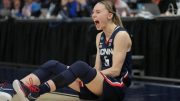I don’t believe in mentioning history just for the sake of it. There must be a reason to commemorate anniversaries, and that reason must be relevant to the present.
There is a big event this year to mark the 50th anniversary of Title IX, the 1972 law that prohibits sex discrimination in federally funded schools and requires them to run women’s intercollegiate sports programs on the same level as their male counterparts.
Because Title IX made the NCAA, which is mostly made up of men, give more opportunities to women in educational activities, including intercollegiate sports, it opened a door for generations of women.
“Title IX pushed a lot of change,” Carla Williams, the athletic director at the University of Virginia, told me earlier this week.
Williams received an athletic scholarship at the University of Georgia, where he played basketball and went on to work in athletic administration. Williams was named the first black female athletic director at a Power 5 school in 2017.
“Would I be here if it weren’t for Title IX?” “I don’t believe so,” she stated. “I wouldn’t have gone to college if I hadn’t been able to afford it.”
The past is linked to the present.
On Friday, the women’s Final Four starts in Minneapolis. It’s also the 40th anniversary of the NCAA taking over women’s championships from the Association for Intercollegiate Athletics for Women (AIAW).
This event resonates across generations because it raises the fundamental question of whether a male-dominated institution such as the NCAA can truly value women in the same way that women value women. Or will it only do so if compelled? What does progress look like given enough time?
“No one wants to impose morality,” Williams explained. People should do things because it’s the proper thing to do. “However, there are times when policy and law must be changed because change will not happen without them.”

University of Virginia athletic director Carla Williams, the first Black female athletic director at a Power 5 school: “Title IX forced a lot of change.”
In some ways, the 40th anniversary is a celebration of how the NCAA has given women’s basketball new chances and increased awareness.
However, the anniversary also tells a familiar story of how a mostly white-male-run institution utilized power and money to improve its brand, comply with the law, and drive out a possible competitor. Basketball was the brand, and the AIAW was the competitor.
For decades, the NCAA treated women as though they didn’t exist as athletes. While males were able to participate in a wide range of sports, particularly football and basketball, women were left out.
“It [women’s sports] was like a little sister that you want to ignore. And all of a sudden, they had to think about us because of this law.”
— Former Texas star Fran Harris on the impact of Title IX
Finally, in 1971, a group of physical education experts established the AIAW—an organization run by women for women. As head coaches and athletic directors, women rose to the top of the ranks. The AIAW met a demand, and its membership grew; by the 1981-82 academic year, the organization had grown to 280 colleges and universities, with 41 championships in 19 sports.
However, Title IX mandated the well-heeled NCAA to provide the same opportunities for women as it did for males, and the NCAA began laying the groundwork for hosting women’s sports championships.
“It meant that sports, which had primarily been governed by men for a long time, now had to think about us,” said Fran Harris, a former University of Texas star, in a phone interview. Harris was the captain of the 1986 Texas women’s basketball team, which went undefeated for the first time in women’s basketball history. “It was like having a younger sister who you wanted to ignore.” And now, because of this law, they had to think about us.
Many AIAW members were adamant in their opposition to the NCAA. When the NCAA got involved, some people thought that meant that women’s sports were going to lose their power over their teams.
In a recent interview, Geno Auriemma, the famed women’s basketball coach at the University of Connecticut, said, “They thought, ‘We have a pretty nice thing going, and now here comes the NCAA and they’re going to take everything.'”
Auriemma was an assistant women’s coach at the University of Virginia at the time of the NCAA takeover. He was well aware of how many of the women felt. “‘They’re going to take it and run with it, and we’re going to lose our own identity, what we had, and our ability to determine our own destiny.'” That irritated a lot of people, he explained.
The NCAA began holding women’s championships in 1982, 76 years after its foundation. When the NCAA took over, many women who had held leadership positions on their campuses under the AIAW were demoted.
Williams witnessed this happen to one of her mentors, Liz Murphey, at the University of Georgia. When Georgia was under AIAW’s jurisdiction, Murphey was the women’s athletic director. Murphey was demoted to assistant athletic director after the NCAA took over.
Auriemma expressed his delight at the NCAA’s decision to replace the AIAW.
He added that he was excited that the NCAA was taking over since he was relatively new and much more of a risk-taker. I considered the possibilities for expanding the game’s reach as well as the game’s audience. I knew exactly how people felt and what they were thinking, and I saw the possibilities. I was on the side of taking chances. “
Some colleges were members of both the AIAW and the NCAA. Some had to make a decision.
At the age of 34, C. Vivian Stringer, a Rutgers Hall of Fame coach, was the head coach at Cheyney State, a historically black institution in Pennsylvania. When Stringer decided her squad would play in the NCAA tournament in 1982, when her team faced Louisiana Tech for the first women’s national title, she did so unwillingly.
Stringer said that she would have liked to compete for the AIAW title, but that money kept her from doing so.
In a 2020 interview, she said, “Quite honestly, I would have wanted to play in the AIAW alongside Texas and Rutgers.” “The trouble was that you’d have to pay for your own transportation there.” Cheyney was a dreadful institution.
We were cash-strapped. My allegiance, though, was to the AIAW, because they were the ones who had always supported competitions. They have recognized and elevated us.

Connecticut coach Geno Auriemma said when the NCAA took over women’s championships in 1982, money and diversity soon followed. “Women’s basketball, at the high school level, at the college level, was a white girl’s game. … Now, suddenly anybody could play.”
The NCAA had financial clout. A common theme in all sports takeovers is that once segregated college sports programs start recruiting talent from historically Black colleges and universities, they hurt historically Black colleges and universities for good. For example, Major League Baseball will eventually shut down Negro League Baseball.
Over 120 large institutions eventually defected from the AIAW to the NCAA, and the AIAW ceased operations in 1982. The AIAW stopped being a thing on June 30, 1983, after a federal antitrust case against the NCAA didn’t work out.
“Opportunities were created that opened up a whole new world for a lot of people. Were some people hurt by those decisions? Yes. That’s always the case. People want progress but they don’t want change.”
— UConn head coach Geno Auriemma on the impact of the NCAA taking over the women’s collegiate championships from the AIAW
The NCAA’s treatment of all women is still unequal forty years later. On the surface, everything appears to be fine, especially in comparison to where women were in 1982. Auriemma, for example, stated that when the NCAA took over and increased the profile of women’s basketball, money followed, as did the number of black players.
“Women’s basketball was a white girl’s game at the high school and college level,” Auriemma stated. “You were white, with a ponytail, and you played basketball or volleyball.” To some extent, the game was finished.
“All of a sudden, shoe corporations stepped in, and all of this money began to flow into AAU programs and trip programs.” Suddenly, everyone could participate. You were not required to pay to play. That opened up a whole new universe, and girls’ basketball has exploded in popularity at both the high school and college levels.
“Opportunities were created that opened up a whole new world for many people,” he continued. Were any people harmed as a result of those decisions? Yes. This has always been the case. People want growth, but they aren’t interested in change. “
Because the NCAA got into trouble over unfairness only last year, critics were right about what they had long thought.
Sedona Prince, a University of Oregon women’s basketball player, recorded a video in March 2021 contrasting the fancy weightlifting equipment offered to males with the inadequate weights provided for the ladies at the start of the tournament. The video went viral, prompting an in-depth probe of the NCAA’s gender disparities.
Following that, a damning investigation exposed the NCAA’s pervasive sexism, in which women were treated as “less than.” The analysis found, among other things, that women’s basketball is undervalued as a source of money.
Has the NCAA’s decision to remove women’s sports from the AIAW been beneficial? “Yes,” Williams confirmed. “Is it where it should be?” No.
“The championships are the same way. Are they superior? Yes. Is it because they were compelled to do so? Yes. I don’t believe you devote your complete concentration to something you don’t want to do but have to do. “
Even as the NCAA commemorates 40 years of holding women’s championships, female athletes continue to face significant challenges. The big question is how will the long-held idea that women’s basketball is always going to lose money change, even though the women’s tournament has never been more popular.
Ying Wushanley, an associate professor at Millersville (Pennsylvania) University and author of Playing Nice and Losing: The Struggle for Control of Women’s Intercollegiate Athletics, 1960–2000, remarked, “The steep mountain will always be there.” “It’ll be a lot closer in twenty years; the gap is closing.” However, for the foreseeable future, there will be a big gap.
Perhaps the mountain will be less steep at institutions like South Carolina, Stanford, and the University of Connecticut, thanks to coaches Dawn Staley and Tara VanDerveer.
“Absolutely,” Auriemma answered when I asked if he anticipated his successor to be a woman. I don’t think this location will ever be coached by a man again. “Not at my school,” she says.
William C. Rhoden, a writer-at-large for Andscape and the author of Forty Million Dollar Slaves, is a former award-winning sports columnist for The New York Times.





